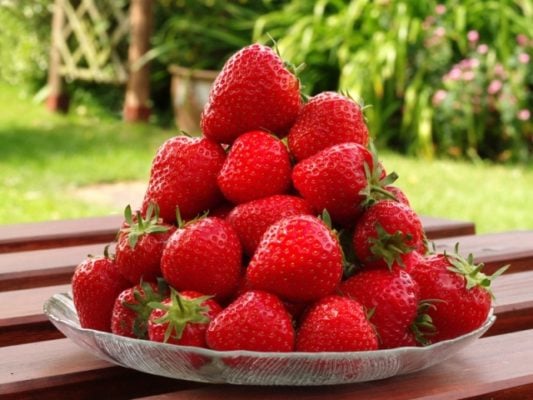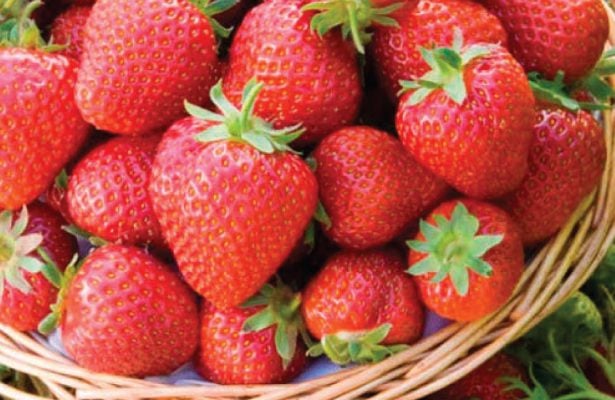
Learning Download: How to Grow Strawberries
From Seed to Harvest: A guide to growing strawberries.
Strawberries are frequently grown from bareroot, which are seeds that have developed and grown into roots, which are then easier to start in a garden. However, it is possible to start strawberry plants from seeds as well, it just takes a longer time and certain steps must be followed to ensure the best growth. Growing strawberries from seed allows the garden to have a wider variety of which types of strawberries they wish to grow.
To plant:
Although bareroot strawberries can be planted at any time, strawberry seeds must be started indoors to ensure they are ready to go when it comes to their normal growing season. To ensure strawberry seeds will grow when you plant them, you must first stratify them. To do this, place the strawberry seeds in an envelope or sealed plastic bag and store them in the refrigerator for a month. Since strawberry seeds must be planted by February to be ready for harvest, begin the stratification process in January. Once the month has passed, remove the seeds but leave them sealed overnight. Open them the next day.
Cold stratification is required for certain seeds to sprout properly. Cold stratification is a process in which seed dormancy is broken by mimicking the natural conditions a seed might go through.
After you have gone through the stratification process, plant the seeds 1/2 inch deep in a container filled with sterile seed-starting mix. Press the seeds into the surface but do not cover them, because in addition to cold stratification, strawberry seeds require light to germinate. Seeds will germinate in one to six weeks. Six weeks after the seeds germinate, transplant them into bigger, individual pots. In another six weeks, your strawberry seedlings are ready to plant outside.
To grow:
Harden off your strawberry seedlings by placing them outdoors in protected areas for half hour increments. Gradually increase the time the plants spend outside. Once they are hardened off, transplant the seedlings into the garden. Space them two feet apart and be sure to plant them in well-drained and acidic soil. Strawberries require full sun to grow. Water the strawberries at least 1 inch a week during their growing season. In addition to growing in a strawberry patch in the garden, strawberry plants also can grow in pots, strawberry towers, raised beds and more. The roots don’t grow deep, meaning the strawberry plant doesn’t need deep soil to grow in.
Once the growing season is over, cut the foliage back to 1 inch. Mulch over the plants with 4 inches worth of straw, pine needles or another type of organic material. Remove the mulch in the spring.
To harvest:
Strawberries are ready to harvest as soon as they turn red. They should be slightly firm to the touch, but if strawberries are too mushy, they can be used to make jellies and jams. Strawberries likely won’t be ready to harvest the first year you plant the seeds because many times, gardeners pinch off the blooms to direct energy into the plant itself. This allows the strawberry plant to direct all of its energy to its roots and leaves, which will need to be strong to produce fruit in the second year of growth.
When they are ready to harvest, cut the berry off at the stem. Do not pull the berry from the stem to harvest it. Unwashed strawberries can be stored in the refrigerator for three to five days.
What strawberries crave:
Begin the fertilizing process when seedlings are still indoors. Start fertilizing with liquid kelp every two weeks for the first month of growth. Use only one tablespoon of kelp per gallon of water to fertilize. After the first month, double the fertilizer strength. Prior to transplanting the strawberries outside, mix ¼ cup of 5-5-5 all-purpose organic fertilizer into the holes meant for each transplant. Water after transplanting and mulch with straw. The last time you will feed the strawberry plants will be after you harvest. At this time, add compost into the soil around the plant. Strawberries are perennials, which means they return each year, and taking care of the soil will allow the strawberries to grow back even stronger than before.
Where to buy strawberry plants:
You can find a wide variety of both strawberry seeds and plants at Urban Farmer.
Learning Download: How to Grow Strawberry Roots
How to: Grow Strawberry Roots
Fresh, sweet strawverries from a homegrown berry patch add to the deliciousness of summer, and gardeners wanting to start their own berry patch usually purchase bare root strawberry plants. Bare roots are the roots of a strawberry plant that are dormant and not planted in soil. To ensure the plant wakes up from its dormant state, bare root strawberry plants must be planted properly.
How to plant bare roots:
It is time to plant bare root strawberry plants once all danger of frost has passed. Prepare the strawberry patch by choosing an area in full sun that has good drainage. Test the soil of the chosen area and make sure the soil pH is between 5.8 and 6.5. Amend the soil with 3 inches of compost and 1 pound of 10-10-10 fertilizer per every 100 square feet of the strawberry patch. Before planting, trim the bare roots to a length of 6 inches. Soak the bare roots in a bucket of water for 20 minutes. Only soak the roots, do not submerge the entire plant. This breaks the dormancy cycle by rehydrating the roots.
Dig holes in the bed the depth of the bare roots and two times as wide. Spread out the roots and keep the crown slightly above the level of the soil. If soil covers the crown, the crown can rot and not produce any plants. Space roots 18 inches apart in rows set 3 inches apart. Water the plants immediately after planting them and lay 2 inches of mulch over the newly planted roots. Water the bed up to 2 inches each week.
Caring for bare root plants:
Once the strawberries wake up and begin to sprout, you can add a side dressing of fertilizer and again after the harvest has ended. After a few seasons of growing the strawberries, the plants will begin to grow runners with baby strawberry plants. Guide the plants across the row as they form and once it is long enough to reach all the way across, encourage the baby plant to grow by weighing down the stem with some weighed object, like a small rock. Every third year you can remove the mother plants and the baby plants will begin to produce, which makes the strawberry patch self-regenerating.
Types of strawberries to choose from:
There are three types of strawberry plants. The most popular strawberry plants are the June-bearing varieties, which produce fruit in May and June. These plants only produce fruit once a year, which makes them good for creating jams and jellies.
There also are ever-bearing strawberry plants, which produce fruit twice a year. Fruit isn’t produced until the second year after planting, and they are ready to harvest in mid-summer and in the fall.
Day Neutral strawberries produce fruit all season long. This is the best variety if gardeners are growing strawberries to eat them fresh.
You can find a large selection of strawberry roots at Urban Farmer.
Learning Download: Strawberry Comparison Chart
Strawberry Comparison Chart
| Type | Variety | Harvest | Color | Planting | Region | Disease Resistant |
| Junebearing | Allstar | mid/late | red | ground, containers, hanging baskets | anywhere | yes |
| Junebearing | Giant | early/mid | red | ground, containers, hanging baskets | Southern | |
| Junebearing | Honeoye | early/mid | red | ground, containers, hanging baskets | anywhere | |
| Junebearing | Sequoia | late | red | containers, hanging baskets | anywhere | yes |
| Junebearing | White Alpine | mid | white | containers, hanging baskets | anywhere | |
| Day-Neutral | Seascape | continuous | red | ground, containers, hanging baskets | Northern | |
| Everbearing | Eversweet | continuous | red | ground, hanging baskets | Southern | yes |
| Everbearing | Fresca | continuous | red | containers, hanging baskets | anywhere | |
| Everbearing | Temptation | continuous | dark red | containers, hanging baskets | anywhere | |
| Everbearing | White Carolina Pineberry | continuous | white | ground, containers | Southern |


